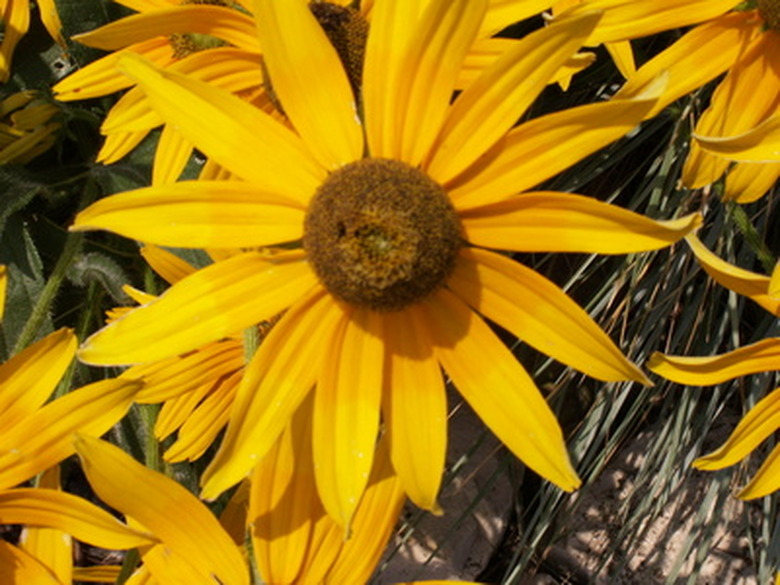The Best Fall Garden Flowers For Houston Texas
Houston, Texas, experiences a humid subtropical climate, which means hot, muggy summers and milder, humid winters. Houston falls within United States Department of Agriculture (USDA) Hardiness Zone 9a. Houston gardeners should select plants according to appropriate hardiness zone, bloom time, flower color, plant hardiness and general culture. Several fall flower varieties perform well in Houston gardens.
Black-Eyed Susan
Black-eyed Susans (Rudbeckia hirta), sometimes called brown-eyed Susans, belong to the daisy family (Asteraceae). This wildflower is perennial in the Houston area, blooming from June through October. Vibrant yellow petals surround black or dark brown center disks. These flowers sit on top of hairy stems ranging from 12 to 24 inches in height.
- Houston, Texas, experiences a humid subtropical climate, which means hot, muggy summers and milder, humid winters.
- Several fall flower varieties perform well in Houston gardens.
Black-eyed Susans grow well in various soils and lighting conditions. Houston gardeners often plant black-eyed Susans in perennial flowerbeds, meadows and wildflower gardens.
Rock Rose
The rock rose (Pavonia lasiopetala), also called the rose mallow and the rose pavonia, belongs to the mallow family (Malvaceae). This flowering shrub reaches about 4 feet in height and prefers dry, limestone soils in partly shady to fully sunny locations. This plant bears leaves with deep green tops and light green undersides.
Showy, pink and yellow flowers bloom from spring through November. Rock rose flowers work well in hummingbird gardens and perennial flowerbeds.
- Black-eyed Susans grow well in various soils and lighting conditions.
- Showy, pink and yellow flowers bloom from spring through November.
Texas Creeping-Oxeye
The Texas creeping-oxeye (Wedelia texana), sometimes called the hairy wedelia, reaches up to 3 feet in height. This daisy family member (Asteraceae) blooms small, yellow or orange flowers from May through November. The grayish-green foliage bears rough hairs.
The Texas creeping-oxeye likes dry soils that receive full sun. Houston gardeners often plant this flower in perennial flowerbeds and butterfly gardens.
Scarlet Betony
The scarlet betony (Stachys coccinea), also called the Texas betony, belongs to the mint family (Lamiaceae) and thrives in moist, loamy or clay soils. This plant features aromatic, deep green leaves, hairy stems and red flowers that bloom from early spring through November. Scarlet betony plants reach up to 3 feet in height and work well in hummingbird gardens.
- The Texas creeping-oxeye (Wedelia texana), sometimes called the hairy wedelia, reaches up to 3 feet in height.
- The scarlet betony (Stachys coccinea), also called the Texas betony, belongs to the mint family (Lamiaceae) and thrives in moist, loamy or clay soils.
Fall Obedient Plant
The fall obedient plant (Physostegia virginiana) belongs to the mint family (Lamiaceae) and naturally thrives along riverbanks in the Houston area. This perennial reaches up to 4 feet in height. Pale purple or pink flower spikes add color to landscapes from August through November. Fall obedient plants prefer humus-rich, moist soils in various lighting conditions. This plant works well in butterfly gardens and hummingbird gardens.
Blood Sage
Blood sage (Salvia coccinea), a perennial plant also called scarlet sage, blooms fragrant, red flowers from late winter through the early autumn. A member of the mint plant family (Lamiaceae), blood sage plants have a pungent smell that keep the deer at a distance.
- The fall obedient plant (Physostegia virginiana) belongs to the mint family (Lamiaceae) and naturally thrives along riverbanks in the Houston area.
Blood sage tolerates various lighting and soil conditions. Houston gardeners often use blood sage in perennial flowerbeds and hummingbird gardens.
Rouge Plant
The rouge plant (Rivina humilis), also known as the pigeonberry, adds color to Houston gardens from spring through late autumn. The rouge plant features light pink flowers on the upper part of the stem, while the lower stem section bears bright red fruit that was once used to make cosmetics.
This pokeweed family member (Phytolaccaceae) reaches about 12 inches in height and likes moist, well-drained soils that receive partial sun. Houston gardeners often use the rouge plant in bird gardens and perennial flower beds.
